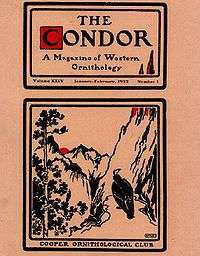The Condor (journal)
 | |
Abbreviated title (ISO 4) | Condor |
|---|---|
| Discipline | Ornithology |
| Language | English |
| Edited by | Philip C Stouffer |
| Publication details | |
| Publisher | |
Publication history | 1899–present |
| Frequency | Weekly |
| Indexing | |
| ISSN |
0010-5422 |
| Links | |
The Condor: Ornithological Applications is a peer-reviewed weekly scientific journal covering ornithology. It is the official journal of the Cooper Ornithological Society.
History
The journal was first published in 1899 as the Bulletin of the Cooper Ornithological Club by a group of biologists in California. The journal's scope was regional, covering the western United States. In 1900 the name was changed to The Condor. In 1947, the journal's subtitle was shortened to The Condor, Journal of the Cooper Ornithological Club.[1]
The first editor was Chester Barlow from 1899 to 1902. From 1902 to 1905 it was Walter K. Fisher, and from 1906 to 1939 Joseph Grinnell edited the journal. Charles A. Nace was publisher. [1]
An editorial board was established in 1951 to address increasing submissions to the journal. James King, of Washington State University, instituted a system for external peer review of submissions. King became editor after Alden H. Miller's death in 1965. Miller replaced Grinnell as editor in 1939. King widened the scope of the journal, and by 1966, at least 40% of papers published in The Condor are written by scientists outside the United States.[1]
In Glenn Walsberg's 1993 "History of The Condor", he concluded that "several thousand people have contributed to the success and development of this journal in its 95-year history. In 1992 alone, 653 scientists aided in its production in the roles of author, reviewer, or both."[1]
In 2014, the American Ornithologists' Union and the Cooper Ornithological Society combined their publishing operations to create the Central Ornithology Publication Office.
1899 editorial
In the prose style of the time period, the first issue's editorial sets out the focus of the journal as "its object being to represent generally the great West, and primarily the Cooper Ornithological Club. It is conceded that the West is rich in its possibilities of new discoveries, both in faunal forms and data regarding the life histories of many species …"
The editorial also comments on a newspaper story from the San Francisco Chronicle about a successful hunt by the Petaluma Sportsmen's Club: "The joint bag showed 821 bluejays and 51 hawks 'of various kinds' slaughtered on the plea that 'each would have destroyed at least five quail’s eggs during the next breeding season.'" The editorial added that "the Bulletin stands for bird protection, and will strenuously oppose wanton slaughter at ail times regardless of its source."[2]
References
- 1 2 3 4 Walsberg, Glenn (1993). "History of The Condor". The Condor. Cooper Ornithological Society. 95 (3): 748–757. doi:10.2307/1369626. Retrieved March 25, 2010.
- ↑ Barlow, Chester; Taylor, Henry Reed; Robertson, Howard (January 1899). "Editorial Notes". Bulletin of the Cooper Ornithological Club. Cooper Ornithological Club. 1 (1): 14. doi:10.2307/1360788.
See also
External links
| Wikimedia Commons has media related to The Condor. |
| Wikisource has original text related to this article: |
- BioOne: The Condor. Vol. 102 (2000) onwards; free HTML abstracts, subscription required for PDF fulltexts. Retrieved 2006-NOV-26.
- SORA: The Condor. Vol. 1–102 (1899–2000) free PDF/DejaVu fulltexts. Retrieved 2006-NOV-26.